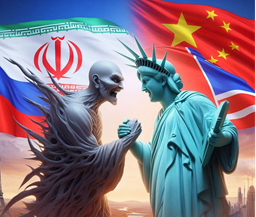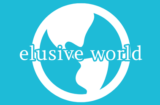by Ron Raskin

On January 29, 2002, U.S. President George W. Bush first used the term “Axis of Evil” in his State of the Union speech. This label originally referred to Iran, Iraq, and North Korea. Later, in 2024, NATO Secretary General Jens Stoltenberg and other leaders used this term again to describe China, Iran, North Korea, and Russia. In response, Iran introduced its own term, the “Axis of Resistance,” which includes Iran, Syria, and Hezbollah. Meanwhile, other members of the “Axis of Evil” have started using terms like “evil democratic axis” for their opponents.
When both sides label each other as “evil,” how can we really tell who is right or wrong? Who is truly “evil,” and who is not? This is especially important today, as many people in the West, particularly those from universities, seem to struggle to differentiate between good and evil. Just a century ago, similar ideas focused on social classes instead of nations or ethnic groups and led to the terrible consequences of communism. It seems that something fundamental is missing in our thinking, something basic that could help people avoid falling into harmful, destructive beliefs.
The first instinct might be to look at philosophy, which has spent a lot of time trying to define what “evil” really is. Generally, there are four main philosophical views on evil: Moral Absolutism, Amoralism, Moral Relativism, and Moral Universalism. I’ll leave it to philosophers to debate which approach is correct, but I’d like to suggest one simple criteria we can use in politics matters to identify evil. This may not be universal, but it seems to align with Western values. Actually, I’m not the first to try this; the UN Charter (like in Article 2(4) and Article 51) already tries to define right and wrong. But these articles aren’t very clear, and the UN has become more of a place for political agendas than a fair guide for justice. Hopefully, the rules below will help everyone reach a more shared understanding
But first, let’s consider a familiar scene: two kids are fighting, and you’re trying to understand how it started. It usually goes something like this:
- “I hit him because he yelled at me.”
- “I yelled because he took my toy.”
- “I asked nicely, but he wouldn’t share. He doesn’t even need it right now!”
- “He kept it yesterday too, so why should I let him have it today?”
- And so on…
This simple, familiar dialogue might actually help us understand the difference between good and evil. From the example above, we can see a key principle that most adults and societies understand: avoid using violence first.
According to this principle, the one who should be held responsible in the dialogue is the person who used violence first where violence means any action that results in human deaths. All other details don’t matter as much because the cycle of blaming could go on forever. This principle seems like something most people worldwide would agree on, but can it really address all the complexities of our world? Here are four corollaries to help answer that question.
Corollary 1: If Alice has more of a resource than Bob, this alone doesn’t justify a violent uprising or “resistance” by Bob. Resistance can only be justified if Alice uses violence to keep things unequal. If Alice is making an effort to create equality or at least isn’t using violence on Bob from achieving it, then there’s no excuse for violence. This aligns with the core principle: avoid using violence first!
Corollary 2: If Alice restricts Bob’s freedom, can Bob use violence to gain it back? Yes, he can. If Alice uses violence to take away Bob’s freedom, then Bob has the right to defend himself and resist—unless Bob’s idea of “freedom” involves destroying Alice. In that case, it’s Alice who is acting in self-defense.
Corollary 3: Another important case from these principles is when Alice knows that Bob is planning to use violence. Should Alice wait and risk getting hurt, or should she act first to prevent it? Potential violence is similar to actual violence. It hasn’t happened yet, but there’s a high chance it will, and the potential of the violence is based on the combination of its likelihood and potential impact, so Alice has the right to defend herself. However, this doesn’t mean she can use excessive force—only what’s necessary for self-defense. Also, the threat should be immediate, not something vague or far-off, as the chance that “anyone could attack anyone sometime” isn’t a sufficient reason for Alice to attack Bob first.
Corollary 4: The third case is when Alice has a resource that Bob wants or believes should be his. If Alice is keeping something from Bob that he truly needs to survive, then Bob may have a right to use violence—otherwise, he might die, which means Alice is indirectly harming him, using the violence. In this case, Bob has a right to defend himself. But if the resource isn’t essential for his survival, then Bob has no justification for violence. Only survival matters, not the quality of life. Just because one country is fortunate enough to have oil while another does not, that doesn’t justify taking it violently.
Corollary 5: The fourth case is if Alice violently took something from Bob. Can Bob use violence to get it back? If the conflict never ended, then Bob has the right to defend himself. But if there was a period of calm where both sides showed a willingness to compromise or stopped fighting, then whoever starts the fight again is the one in the wrong. Just like a grown man can’t hit someone today just because of a fight yesterday, Bob can’t use past harm as a reason to attack Alice now. Revenge is not the same as justice.
With this background in mind, we can return to the main question: What makes the “Axis of Evil” truly evil? Russia’s attack on Ukraine—whether to reclaim past territory or regain global power it once had—is no justification for violence. Similarly, while Palestinians deserve their own state, claiming all of Israel/Palestine does not justify violence under the name of “resistance.” Unlike the Palestinians, Israel has no land for its survival beyond the area within the Green Line, whereas the Palestinians have enough land in the West Bank and Gaza to meet their needs. Fancy terms like “resistance” shouldn’t hide the reality: violence is never justified and only leads to more violence and wars, as we saw 100 years ago when Germany, feeling that it was unfairly treated by the world, became the Nazi regime.
To sum up: Hopefully, this principle “don’t use violence first” and the five corollaries will provide the base for our mutual agreement and understanding of what is good and what is evil in geopolitical relations, and will help us all to make the world better.
P.S.
One point to clarify in this post is the difference between “force” and “violence.” In this post, the distinction is similar to that between force and energy in physics: “A force is an influence that can cause an object to change its velocity”, “Energy is always equivalent to the ability to exert force against an object that is moving along a definite path of certain length”. In the context of conflict, violence is the act of using force against an opponent. In simpler terms, force exists; using that force creates violence.
This distinction though influenced by Pierre de Villiers in his article: “Force and violence” varies from his definition: “…violence is a denial of the Other, while force implies control over power. Force is concerned by the fate of the Other, it rejects the cruelty to which violence often leads. Force can be asserted, violence is unleashed. On one side there is rationalised passion, and on the other, devastating passion”

